|
|
 |
|
Calanoida ( Order ) |
|
|
|
Clausocalanoidea ( Superfamily ) |
|
|
|
Phaennidae ( Family ) |
|
|
|
Cornucalanus ( Genus ) |
|
|
| |
Cornucalanus robustus Vervoort, 1957 (F,M) | |
| | | | | | | Syn.: | Cornucalanus chelifer : Wolfenden, 1911 (p.283, figs.F);
Cornucalanus antarcticus Brodsky & Zvereva, 1976 (p.185, figs.F) | | | | Ref.: | | | Vervoort, 1957 (p.88, Descr.F, figs.F, Rem.); 1965 (p.33, Rem.); Park, 1983 a (p.358, figs.F,M, Rem.); Razouls, 1994 (p.100, figs.F,M); Bradford-Grieve & al., 1999 (p.880, 929, figs.F) | 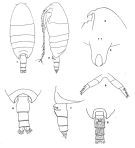 Female: 1, 2, habitus (dorsal, lateral); 3, Head (lateral); 4, Rostrum; 5, P5; 6, 7, Th5 and Urosome (dorsal, lateral); issued from : Park, 1983. 8, Urosome (ventral); issued from : Brodsky & Zvereva, 1976 (as Cornucalanus issued from : Parkantarcticus).
|
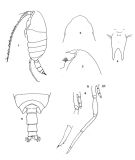 Male: 1, habitus (lateral); 2, 3, Head (dorsal, lateral); 4, Rostrum; 5, Th5 and Urosome (dorsal); 6, P5; issued from : Park in Antarct. Res. Ser; Washington, 1983, 39 (5): 317-368.
|
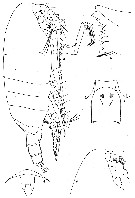 issued from : W. Vervoort in B.A.N.Z. Antarctic Reseach Expedition, Report Ser. B, Vol. III., 1957 [Fig.72] Female (from 61°44'S, 77°59'E): a, habitus (lateral); b, Md (cutting edge); c, genital somite (ventral); d, rostrum (ventral view); e, forehead (lateral).
|
 issued from : W. Vervoort in B.A.N.Z. Antarctic Reseach Expedition, Report Ser. B, Vol. III., 1957 [Fig.73] Female: a-b, right A1; c, left Mxp; d, P5.
|
 issued from : W. Vervoort in B.A.N.Z. Antarctic Reseach Expedition, Report Ser. B, Vol. III., 1957 [Fig.74] Female: a-b, posterior part cephalothorax and urosome (lateral and dorsal, respectively); c, right Md (mandibular palp); d, habitus (dorsal).
|
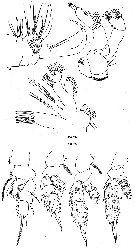 issued from : W. Vervoort in B.A.N.Z. Antarctic Reseach Expedition, Report Ser. B, Vol. III., 1957 [Fig.s75, 76] Female: Fig.75: a, left Mx2; b, left A2; c, left Mx1. Fig.76: a, right P1 (posterior); b-d, P2 to P4 (left legs, posterior).
|
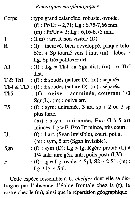 Issued from : C. Razouls in Ann. Inst. océanogr., Paris, 1994, 70 (1). [p.100]. Caractéristiques morphologiques de Cornucalanus robustus femelle et mâle adultes. Terminologie et abbréviations: voir à Calanus propinquus.
| | | | | Compl. Ref.: | | | Björnberg, 1973 (p.331, 385); Hopkins, 1985 (p.197, Table 1, gut contents); Hopkins & Torres, 1988 (tab.1); Noda & al., 1998 (p.55, Table 3, occurrence); Voronina & Kolosova, 1999 (p.71); Razouls & al., 2000 (p.343, tab. 3, Appendix); Schnack-Schiel & al., 2008 (p.1045: Tab.2); Park & Ferrari, 2009 (p.143, Table 4, 7: common deep water species, Appendix 1, biogeography) | | | | NZ: | 4 | | |
|
Distribution map of Cornucalanus robustus by geographical zones
|
| | | | | |  issued from : W. Vervoort in B.A.N.Z. Antarctic Reseach Expedition, Reports - Ser. B, Vol. III, 1957 [Fig.71]. issued from : W. Vervoort in B.A.N.Z. Antarctic Reseach Expedition, Reports - Ser. B, Vol. III, 1957 [Fig.71].
Chart showing the geographical distribution (white triangle) in the seas surrounding the Antarctic continent.
Nota: In this chart the area frequented by whaling vessels has been hatched. The Antarctic circle (66°.5 S) has been drawn as a broken line. The numbers I to VI refer to the sectors into which the Antarctic seas are divided according to Mackintosh (1942) (after Vervoort, 1951). |
| | | | Loc: | | | Antarct. (Croker Passage, Drake Passage, Weddell Sea, SW & SE Atlant., Indian, SW & SE Pacif.), sub-Antarct. (Indian, SW & SE Pacif.), G. of Guinea, Atlant. (equatorial), S Chile, | | | | N: | 10 | | | | Lg.: | | | (15) F: 7,66-6,75; M: 6,75-6,16; (16) F: 8,6-7,1; (25) F: 7,34-7,07; (444) F: 7,3-7,25; {F: 6,75-8,60; M: 6,16-6,75} | | | | Rem.: | bathypelagic.
Sampling depth (Antarct., sub-Antarct.) : 500-1000 m.
Concerning males see remarks to C. indicus from Tanaka & Omori (1992, p.260-261).
For Vervoort (1963 b, p.34), the occurence of this species in the Gulf of Guinea, is a surprise, but there is no doubt about their identity. it is thus necessary to revise previously expressed opinion that the species is a characteristic Antarctic deep water copepod; The species probably has a much wider distribution in deep water of the Atlantic Ocean, penetrating into the deeper waters of the Antarctic. In the Indian sector of the Antarctic, the species has also been recorded from north of the Antarctic convergence and in the extreme south of the Indian Ocean. Wolfenden (1911) mentions one tropical locality (0°46'N, 18°59'W which is in the vicinity of Atlantide Expedition (1°30'N, 10°10'W). | | | Last update : 28/01/2017 | |
|
|
 Any use of this site for a publication will be mentioned with the following reference : Any use of this site for a publication will be mentioned with the following reference :
Razouls C., Desreumaux N., Kouwenberg J. and de Bovée F., 2005-2025. - Biodiversity of Marine Planktonic Copepods (morphology, geographical distribution and biological data). Sorbonne University, CNRS. Available at http://copepodes.obs-banyuls.fr/en [Accessed August 29, 2025] © copyright 2005-2025 Sorbonne University, CNRS
|
|
 |
 |











